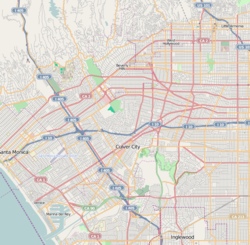South Carthay
| South Carthay | |
|---|---|
| Neighborhood of Los Angeles | |

South Carthay signage located at
1025 S. Crescent Heights Boulevard (just south of Olympic Boulevard) |
|
| Location within Los Angeles | |
| Coordinates: 34°03′41″N 118°22′11″W / 34.0613272°N 118.3696349°WCoordinates: 34°03′41″N 118°22′11″W / 34.0613272°N 118.3696349°W | |
| Country |
|
| State |
|
| County |
|
| Time zone | Pacific |
| Zip Code | 90048 |
| Area code(s) | 323 |
South Carthay is a neighborhood in Central Los Angeles, California. Located south of Carthay Circle, South Carthay was developed in the 1930s by Spyros George Ponty.
The neighborhood is bounded by Olympic Boulevard om the north, La Cienega Boulevard on the west, Pico Boulevard on the south, and Cresecent Heights Boulevard on the east.
The South Carthay area became a portion of the City of Los Angeles on February 28, 1922. Residential development in the area began during the early 1930s on land that previously grew produce for Ralphs markets. Greek developer Spyros George Ponty worked with architect Alan Ruoff to design 147 modest Mediterranean-style homes in the area. While the builder's influence is found in Westwood, Norwalk, Beverly Hills, South-Central Los Angeles and the San Fernando Valley, South Carthay's Spanish Colonial Revival homes represents one of his earliest legacies. All of the 147 homes designed by Ponty share red-tiled roofs and stucco exterior walls, wrought iron and glazed-tile detailing. Yet each home was built slightly differently from the next, with flipped floor plans and doors and windows in different places. South Carthay remains an architecturally cohesive community, with few intrusions from the succeeding decades.
In 1984, South Carthay became the second neighborhood in the city to receive the designation of Historic Preservation Overlay Zone (HPOZ). The South Carthay preservation plan was adopted by the City of Los Angeles on December 9, 2010. Objectives of the HPOZ include: Safeguarding the character of historic buildings and sites and recognizing and protecting the historic streetscape and development patterns. The HPOZ boundaries exclude the commerical thoroughfares of Pico Boulevard and La Cienega Boulevard.
...
Wikipedia

